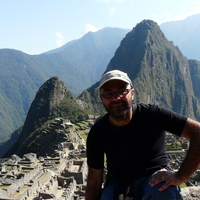
Saverio Scerra
Saverio Scerra was born in Ragusa (Sicily-Italy) on January 19th 1964
On march 1989 he graduated in Arts and Archaelogy with full marks and honours and in the same year, he was winner of a two-year scholarship from the National Research Council at the Center for Greek Archeology at the University of Catania, where he carried out research in the field of Attic, Italiot and Siceliot ceramography.
From 1989 to 1994 he was a member of the archaeological missions in Nea Paphos (Cyprus) directed by Prof. Filippo Giudice, Professor of Archaeology of Magna Graecia at the Archeology Department at the University of Catania.
In 1994 he obtained a scholarship by the Italian Ministry of Foreign Affairs to carry out research on the island of Cyprus.
Since 1996 he hold a diploma of Specialization in Archeology at the School of Specialization in Archeology at the University of Catania.
From 1995 to 1998 he coordinated the restoration of the Archaeological Museum and the archaeological areas of Lentini on behalf of the Soprintendenza ai Beni Culturali of Syracuse, where he co-directed archaeological excavations along the fortification walls of the ancient city of Leontinoi.
From 1994 to 2005 he was a professor of Latin and Greek and taught at the Classical High Schools of Vittoria, Ragusa, Modica, Comiso and Ispica
Winner of a competition for Archaeologist, since 2005, is an archaeologist of the Sicilian Region, at the Department for Cultural Heritage of the same Region and carries out its activities at the Soprintendenza ai Beni Culturali di Ragusa.
He carried out archaeological excavations throughout the Ragusa district, including those of the Late hypogeum of Cisternazzi in Ragusa countryside and very near to there, of roman bath transformed in a late cemetery basilica, of the Greek necropolis of Serracarcara near Comiso and those inside the stables of Palazzo Polara in Modica that allowed discovery of a sepulchral area dating back to the late Republican age and the early imperial age. Moreover he directed the excavation of a settlement of the Early Bronze Age in the contryside of Ragusa (contrada Cimillà) and of a village of the Copper Age in the southern outskirts of the same city (contrada Colombardo).
Currently with a team from the University of Bologna, Alma Mater, he is coordinating a research project related to a cemetery area of the late Imperial and Byzantine age, in the San Nicola near Chiaramonte Gulfi (RG); with another team from the Loyola University of Chicago, John Felice Center in Rome, he is coordinating others archaeological excavations in a vicus betwen Comiso and Chiaramonte Gulfi (contrada Cifali).
In 2012 he coordinated the archaeological excavation activities of the sites in Ragusa as part of the Italian-Malta "Archaeotur" European Project aimed at enhancing some of the Hyblaean and Maltese archaeological sites.
He had the scientific direction of highly successful exhibitions such as "Gli Argenti di Paternò" (Ragusa 2005-2006), "Elmi per gli uomini, Elmi per gli Dei" (Ragusa 2008), "I Tesori di Modica" (Modica 2013)
He is author of numerous scientific publications and is also an underwater archaeologist and diver and deals with navigation and ships from the Greek period to the modern age.
On march 1989 he graduated in Arts and Archaelogy with full marks and honours and in the same year, he was winner of a two-year scholarship from the National Research Council at the Center for Greek Archeology at the University of Catania, where he carried out research in the field of Attic, Italiot and Siceliot ceramography.
From 1989 to 1994 he was a member of the archaeological missions in Nea Paphos (Cyprus) directed by Prof. Filippo Giudice, Professor of Archaeology of Magna Graecia at the Archeology Department at the University of Catania.
In 1994 he obtained a scholarship by the Italian Ministry of Foreign Affairs to carry out research on the island of Cyprus.
Since 1996 he hold a diploma of Specialization in Archeology at the School of Specialization in Archeology at the University of Catania.
From 1995 to 1998 he coordinated the restoration of the Archaeological Museum and the archaeological areas of Lentini on behalf of the Soprintendenza ai Beni Culturali of Syracuse, where he co-directed archaeological excavations along the fortification walls of the ancient city of Leontinoi.
From 1994 to 2005 he was a professor of Latin and Greek and taught at the Classical High Schools of Vittoria, Ragusa, Modica, Comiso and Ispica
Winner of a competition for Archaeologist, since 2005, is an archaeologist of the Sicilian Region, at the Department for Cultural Heritage of the same Region and carries out its activities at the Soprintendenza ai Beni Culturali di Ragusa.
He carried out archaeological excavations throughout the Ragusa district, including those of the Late hypogeum of Cisternazzi in Ragusa countryside and very near to there, of roman bath transformed in a late cemetery basilica, of the Greek necropolis of Serracarcara near Comiso and those inside the stables of Palazzo Polara in Modica that allowed discovery of a sepulchral area dating back to the late Republican age and the early imperial age. Moreover he directed the excavation of a settlement of the Early Bronze Age in the contryside of Ragusa (contrada Cimillà) and of a village of the Copper Age in the southern outskirts of the same city (contrada Colombardo).
Currently with a team from the University of Bologna, Alma Mater, he is coordinating a research project related to a cemetery area of the late Imperial and Byzantine age, in the San Nicola near Chiaramonte Gulfi (RG); with another team from the Loyola University of Chicago, John Felice Center in Rome, he is coordinating others archaeological excavations in a vicus betwen Comiso and Chiaramonte Gulfi (contrada Cifali).
In 2012 he coordinated the archaeological excavation activities of the sites in Ragusa as part of the Italian-Malta "Archaeotur" European Project aimed at enhancing some of the Hyblaean and Maltese archaeological sites.
He had the scientific direction of highly successful exhibitions such as "Gli Argenti di Paternò" (Ragusa 2005-2006), "Elmi per gli uomini, Elmi per gli Dei" (Ragusa 2008), "I Tesori di Modica" (Modica 2013)
He is author of numerous scientific publications and is also an underwater archaeologist and diver and deals with navigation and ships from the Greek period to the modern age.
less
Related Authors
Anna Maria Sammito
Regione Siciliana
Vittorio Rizzone
Facoltà Teologica di Sicilia (Studio Teologico San Paolo di Catania)
Giuseppe Guzzetta
Catania
Angela Bellia
Consiglio Nazionale delle Ricerche (CNR)
Stefania Alfarano
University College London
InterestsView All (7)










Uploads
Papers by Saverio Scerra
SUMMARY - INTERNAL DEVELOPMENTS AND EXTERNAL LINKS IN CALAFORNO: NEW INVESTIGATIONS IN THE AREA OF THE ENTRANCE TO THE HYPOGEUM - The paper offers a brief account of the recent excavations carried out by Soprintendenza BB. CC. AA. of Ragusa in the area in front of the access to the Calaforno Hypogeum (2016-2019). The focus is on the exceptional megalithic structures that monumentalized the entrance to the Hypogeum in the Late (Building 1, Dromos and Western Wall) and Final (Building 2) Eneolithic. A scattered frequentation is also attested in the Early and Middle Bronze Age, and in the Late Classical/Hellenistic Age, when this sector experienced a new building phase associated with ritual depositions. The substantial ceramic contexts associated with the megalithic phases, among which some fragments of Thermi ware have been recovered, offer interesting insights for a better definition of the chronology of the late (Malpasso phase) and final (S. Ippolito phase) Eneolithic in Sicily and in the contemporary Mediterranean context.
SUMMARY - INTERNAL DEVELOPMENTS AND EXTERNAL LINKS IN CALAFORNO: NEW INVESTIGATIONS IN THE AREA OF THE ENTRANCE TO THE HYPOGEUM - The paper offers a brief account of the recent excavations carried out by Soprintendenza BB. CC. AA. of Ragusa in the area in front of the access to the Calaforno Hypogeum (2016-2019). The focus is on the exceptional megalithic structures that monumentalized the entrance to the Hypogeum in the Late (Building 1, Dromos and Western Wall) and Final (Building 2) Eneolithic. A scattered frequentation is also attested in the Early and Middle Bronze Age, and in the Late Classical/Hellenistic Age, when this sector experienced a new building phase associated with ritual depositions. The substantial ceramic contexts associated with the megalithic phases, among which some fragments of Thermi ware have been recovered, offer interesting insights for a better definition of the chronology of the late (Malpasso phase) and final (S. Ippolito phase) Eneolithic in Sicily and in the contemporary Mediterranean context.
La terza edizione di Landscape vuole tentare di declinare questa tematica nell'antichità, cercando di comprendere il livello di consapevolezza ecologica delle società antiche ed evidenziando quali sono state le scelte politiche ed economiche attuate tenendo in considerazione la componente ambientale.
Il convegno, organizzato in collaborazione con l'Università di Bologna e la Consulta di Topografia Antica, si terrà tra il 5 ed il 6 maggio 2022 a Bologna e Ravenna.